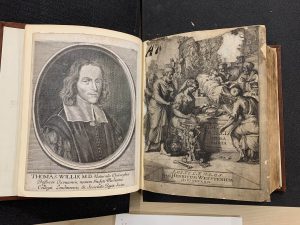 Thomas Willis (1621-1675) was a successful English physician, professor of natural sciences at Oxford, and a founding member of the Royal Society. He was an example of a physician who, instead of embracing classical authority, chose to study things based on direct observations. He was also the first to argue that research into the anatomy of the brain was the necessary foundation to speculations about the mind. Falk Library owns his work “Opera Omnia,” published in 1682 in Amsterdam by Henricus Wetstein.
Thomas Willis (1621-1675) was a successful English physician, professor of natural sciences at Oxford, and a founding member of the Royal Society. He was an example of a physician who, instead of embracing classical authority, chose to study things based on direct observations. He was also the first to argue that research into the anatomy of the brain was the necessary foundation to speculations about the mind. Falk Library owns his work “Opera Omnia,” published in 1682 in Amsterdam by Henricus Wetstein.
Before Thomas Willis, studies of brain anatomy and the organization of the nervous system were rather vague, based on Galen’s belief that the brain’s main function was to purify the spirits that were blamed for most human diseases. His predecessors had to work with a disintegrated organ since there was no way of preserving delicate brain tissue. Willis took advantage of the intravenous injection method developed by Christopher Wren in order to preserve the organ and study the brain in its normal form. The result was his famous work on the anatomy of the brain and nervous system, “Cerebri Anatome,” published in 1664 as the first complete and accurate description of the nervous system. In it, he coined several terms that are still in the medical dictionary, such as neurology, optic thalamus, vagus nerve, corpus striatum, anterior commissure, and internal capsule. The detailed drawings included in “Cerebri Anatome” were unprecedented. He also wrote two more comprehensive books on the brain and nervous system: “Pathologiae cerebri, et nervosi generis specimen” in 1667 and “De Anima Brutorum” in 1672. With these works, he raised the study of the nervous system to a new level.
In addition to the three works already mentioned, “Opera Omnia” also includes “Diatribae Duae Medico-Philosophicae” (1659), two treatises on fermentation and fevers; “Affectionum que Dicuntur Hystericae & Hypochondriacae” (1670), a treatise on hysteria; and “Pharmaceutice Rationalis” (1675), a treatise on effects of drugs on the human body. “Opera Omnia” is illustrated and includes the author’s portrait. The title page bears signs of repairs and the pages show some foxing, but the volume is in very good condition, bound in a new full leather binding, though with an erroneous date of 1672 on the spine. A unique feature of Falk Library’s copy is a handwritten table of contents added to the last work.
~Gosia Fort